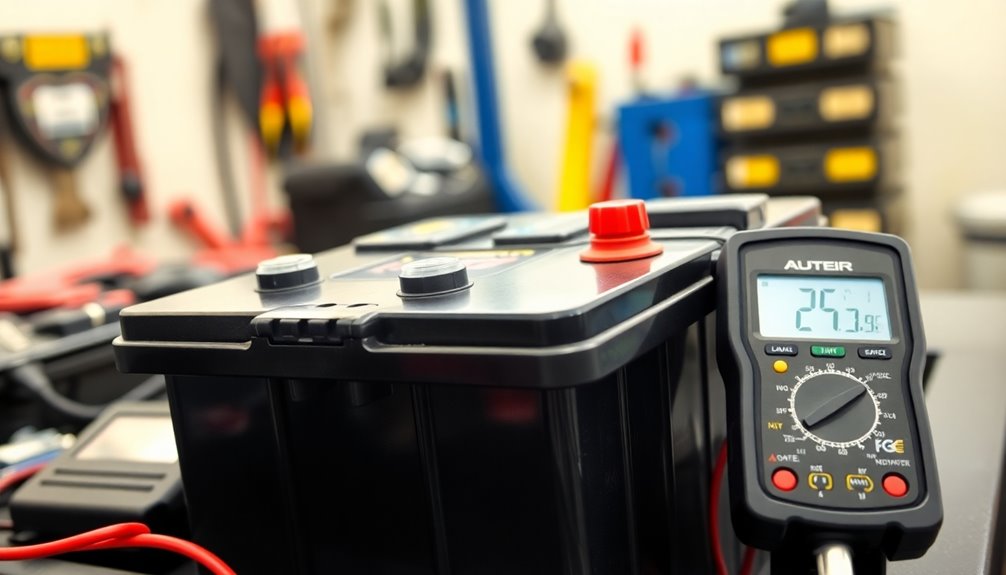EV battery degradation happens mainly because of chemical reactions and temperature effects, causing capacity loss over time. Fast charging, deep discharges, and high temperatures accelerate wear, while cold weather can temporarily dim performance. To prolong your battery’s lifespan, avoid full charges, limit fast charging, and keep the battery within ideal temperature ranges. Proper thermal management and following manufacturer advice can make a difference—continue exploring to discover effective ways to protect your EV’s battery.
Key Takeaways
- Battery degradation primarily results from chemical reactions, SEI layer formation, and temperature-related effects during charging cycles.
- High temperatures accelerate chemical wear, increasing degradation rates, while cold temperatures temporarily impair performance.
- Deep discharges and full charges, especially with fast charging, hasten capacity loss and battery aging.
- Proper thermal management, avoiding extreme temperatures, and following manufacturer guidelines help prolong battery lifespan.
- Regular maintenance and limiting aggressive charging practices can significantly reduce degradation and enhance long-term performance.

Electric vehicle batteries naturally degrade over time, impacting the vehicle’s range and performance. This process is influenced by various factors, including the internal chemistry of the battery and how well it is managed during use. Understanding these elements can help you better grasp why your EV’s range diminishes and what you can do to extend its lifespan.
The core of battery degradation lies in the battery chemistry itself. Most EVs use lithium-ion batteries, where lithium ions shuttle between the anode and cathode during charging and discharging. Over many cycles, the chemical reactions can cause the formation of solid electrolyte interphase (SEI) layers and other byproducts that diminish the battery’s capacity. As these reactions progress, fewer ions are available to generate power, reducing overall performance. High temperatures accelerate these chemical changes, which is why managing the thermal environment of your battery is so *vital*. Proper thermal management systems prevent the battery from overheating or experiencing extreme cold, both of which can speed up chemical degradation. When the battery gets too hot, it not only degrades faster but also risks safety issues. Conversely, cold temperatures slow down chemical reactions, leading to reduced performance. Effective thermal management ensures a stable temperature range, helping to preserve battery health over time.
Battery chemistry causes degradation; managing temperature prevents faster wear and maintains performance over time.
You can’t entirely prevent degradation, but you can take steps to slow it down. Regularly avoiding deep discharges and not always charging to 100% can help prolong your battery’s life. Many EVs now come with built-in battery management systems that monitor and regulate temperature, voltage, and current to *maximize* longevity. Keeping an eye on these systems and following manufacturer guidelines can make a big difference. Additionally, parking in shaded or insulated areas helps maintain a stable temperature, reducing thermal stress. Limiting fast charging when unnecessary also reduces heat buildup inside the battery, minimizing chemical wear. If your vehicle offers options for thermal management or cooling modes, make use of them, especially during extreme weather conditions. Proper maintenance and mindful usage help *maintain* that your battery’s chemistry remains as stable as possible for as long as possible. Moreover, understanding the importance of high-quality battery components can contribute to better long-term performance and durability.
In the end, understanding how battery chemistry and thermal management influence degradation empowers you to take better care of your EV. While some decline is *inevitable*, adopting good habits and leveraging your vehicle’s technology can *greatly* extend its effective lifespan, keeping you on the road longer with *peak* performance.
Frequently Asked Questions
How Do Temperature Fluctuations Specifically Impact Battery Lifespan?
Temperature fluctuations cause thermal cycling and temperature shock, which directly impact your EV battery’s lifespan. When temperatures vary rapidly or repeatedly, it stresses the battery cells, leading to faster degradation. Thermal cycling causes expansion and contraction, weakening internal structures, while temperature shock creates immediate damage from sudden changes. To maximize battery life, avoid exposing your EV to extreme, fluctuating temperatures and try to keep it within an ideal temperature range.
Can Software Updates Improve or Reverse Battery Degradation?
Yes, software updates can improve battery performance and sometimes slow degradation, but they can’t completely reverse existing damage. By implementing software optimization and firmware improvements, manufacturers can better manage charging rates, temperature control, and power distribution, which helps extend your EV battery’s lifespan. Regular updates ensure your vehicle uses the latest strategies to optimize battery health, ultimately improving efficiency and reducing unnecessary wear over time.
What Are the Best Storage Practices to Minimize Degradation?
Like a vintage vinyl, your EV battery needs proper storage to stay at its best. For ideal storage, keep the battery between 30-50% charge and in a cool, dry place. Avoid extreme temperatures and long periods of inactivity. Regular battery conditioning helps maintain health. These practices prevent capacity loss, reduce degradation, and extend your EV’s lifespan, ensuring you enjoy reliable performance for miles to come.
Are There Differences in Degradation Rates Among Various EV Brands?
Yes, degradation rates vary among EV brands due to differences in brand reliability and manufacturing quality. You’ll find that some brands, like Tesla and Hyundai, tend to have more durable batteries because of stricter quality controls and advanced technology. Conversely, lesser-known brands might experience faster degradation. When choosing an EV, consider brand reputation and manufacturing standards, as these factors directly influence your battery’s lifespan and overall vehicle reliability.
How Does Frequent Fast Charging Accelerate Battery Wear?
Think of your battery as a delicate dancer, vulnerable to rapid movements. Frequent fast charging exposes it to thermal stress, which accelerates wear. Rapid charging causes quick temperature spikes that strain the battery’s chemistry, leading to faster degradation over time. While convenient, relying heavily on fast chargers can shorten your battery’s lifespan. To protect it, use fast charging sparingly and allow your battery to cool down between sessions.
Conclusion
Just as the phoenix rises renewed from ashes, understanding and addressing EV battery degradation can help you extend your battery’s life and performance. By knowing the causes, monitoring rates, and applying prevention strategies, you take control of your electric journey. Don’t let unseen wear bring your ride to a halt; instead, be the hero of your own story, safeguarding your battery’s future and keeping your adventures alive and vibrant for miles to come.









